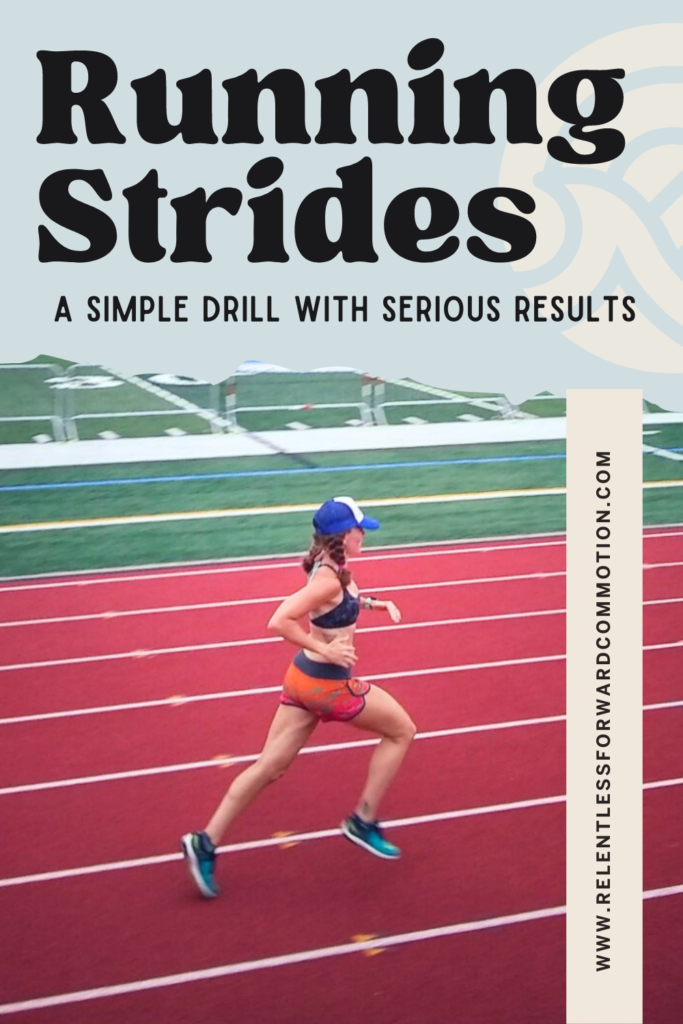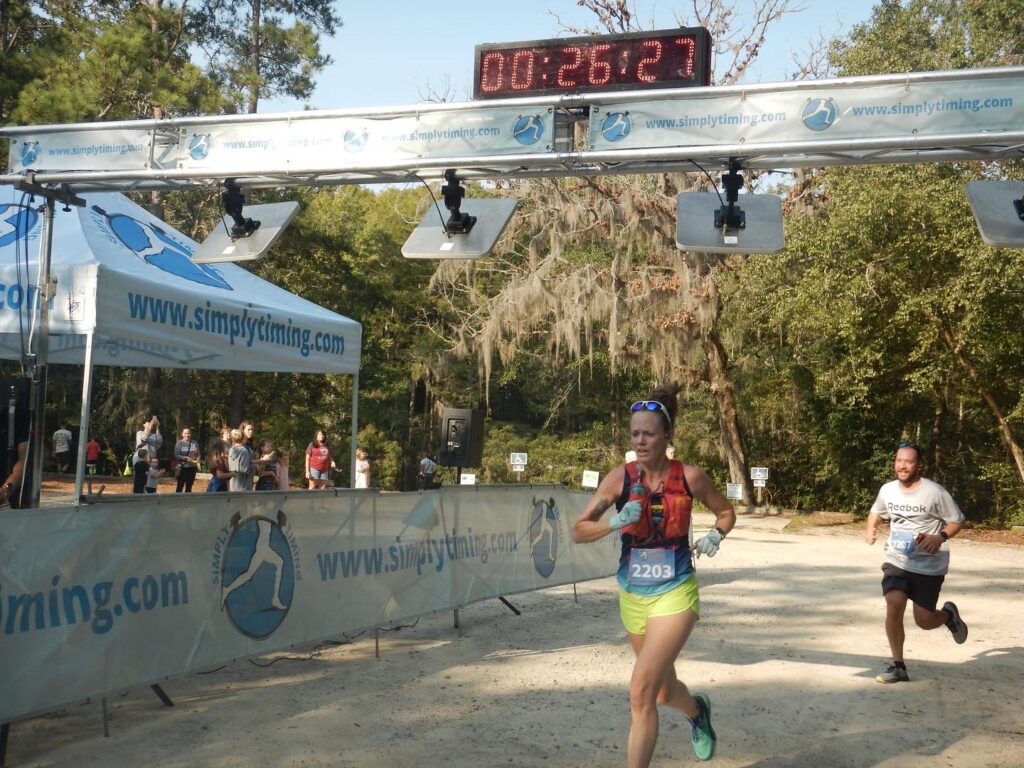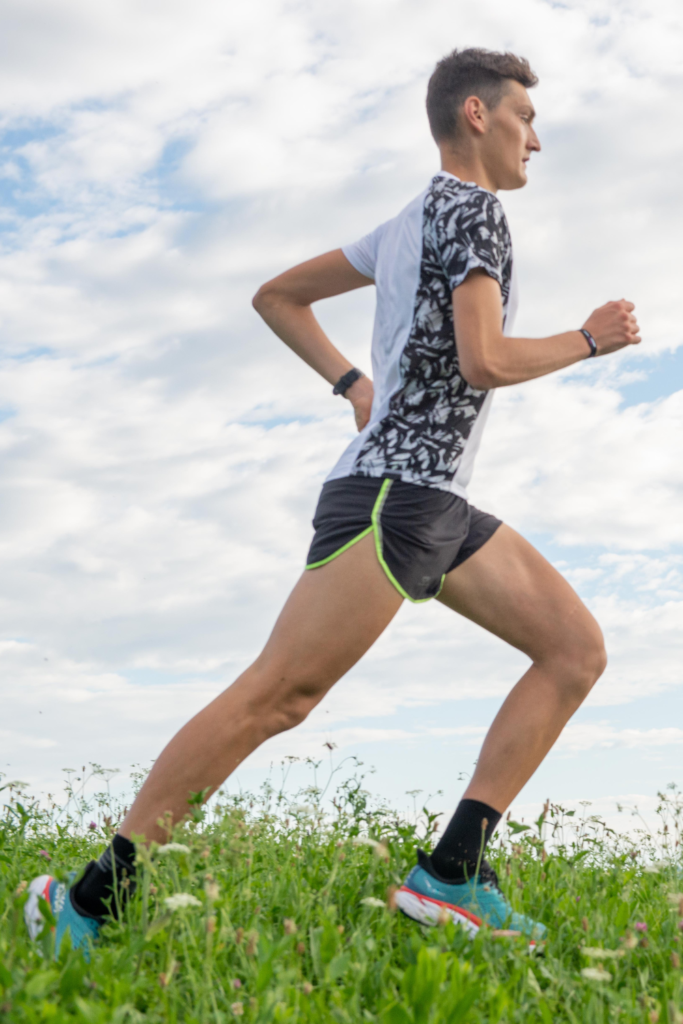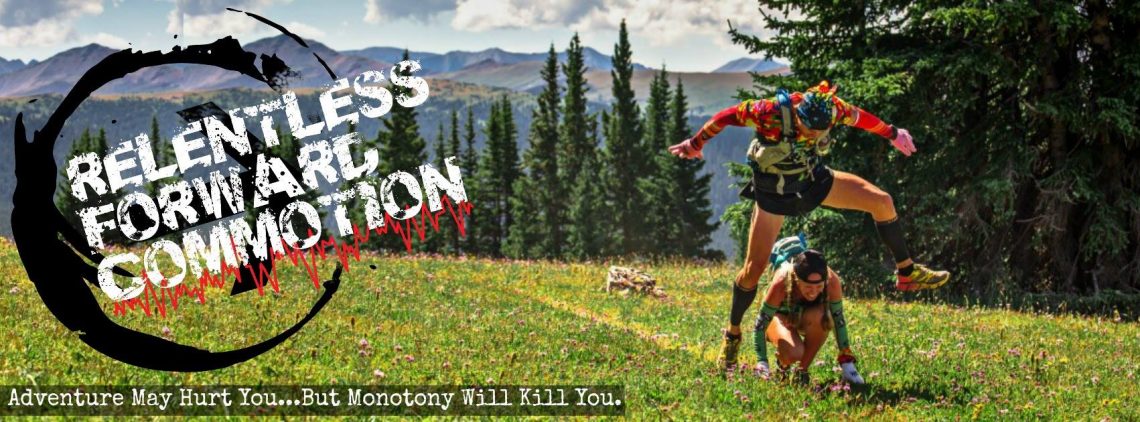Last Updated on August 8, 2023 by Heather Hart, ACSM EP, CSCS
Chances are if you are reading this article, you are a trail and/or ultra runner dreaming of gnarly single track and beautiful mountain vistas – not contemplating your next fast 5K finish. As such, you may have the notion that strides are one of those running drills reserved for those who spend a lot of time on a track, and wear light weight carbon plated shoes.
Well, you’re wrong.
Running strides are a simple to execute drill that can yield big time running performance results for almost all runners – trail and ultra crowd included.
Further, even those of you who loathe speedwork (I’m looking at you still, my ultrarunners) can benefit from running strides, while avoiding that awful “I can’t breathe and I might puke” feeling of a full speed workout.

What are Strides in Running Workouts?
Strides are a running drill where an athlete progressively increases their speed from an easy jog to about 80-95% of maximum speed, then gradually slows down to a stop, all over the course of about 20-30 seconds.
Typically, running form is slightly exaggerated during a stride to help a runner practice and become more familiar with this movement pattern.
Running strides are sometimes also referred to as striders, stride-outs, pick-ups, or accelerations (or “those things coach makes me do at the end of a workout”).
Strides vs Sprints
While they may seem similar, running strides and running sprints are not the same thing. A sprint is typically 10 +/- seconds of all out, 100% running effort, done with the purpose of increasing anaerobic capacity.
Running strides, however, are more akin to a form drill, where the goal is improving running mechanics. Further strides should be performed at a hard – but not maximal – effort.
What are the Benefits of Running Strides?
The purpose of strides is not to build aerobic fitness or endurance, but rather, to help improve foot turnover and running biomechanics at faster paces. And this can be useful in a number of ways:
1. Improved Running Economy
Practice makes perfect: by using strides as a drill to improve running mechanics, you will in turn improve running economy (essentially, making it “easier” for your body to run at a given effort/pace). This is because strides help train your neuromuscular system, teaching your brain to send signals to your muscles, and your muscles to respond more effectively while running at harder efforts, as well as varying intensity (speeding up and slowing down).
2. Building Strength
A 2018 study published in Physiological Reports had twenty-six trained male and female runners incorporate 10 sessions of 30-second strides over a period of 40 days. Not only did these runners improve their 10K time by over 3%, but researchers believe that the strides altered protein expression in slow-twitch muscle fibers.
The study found that levels of dystrophin, a protein that helps transmit forces generated by the actin‐myosin cross‐bridge in muscle fiber cells, increased in slow-twitch muscle fibers with after incorporating running strides. The study notes that the higher expression of dystrophin in these slow-twitch fibers may have enhanced the structural integrity of the muscle fibers, which in turn positively influenced running economy.
While this of course is no substitution for regular strength training, improving structural integrity of muscle fibers is a fantastic way to possibly mitigate injury.
3. Introductory Speed Workout for Beginners
Traditional speed workouts are physically and mentally demanding, and are often beyond the current abilities of beginner runners. Strides, however, can be a perfect introductory speed workout for beginners, as they let a runner ease into and briefly “touch” and experience a similar intense effort, without putting too much demand on the body.
4. Pre-Race or Hard Workout Warm Up
Let’s face it: not all of us feel as graceful as Usain Bolt when we run hard and fast. Strides can be used as a dynamic warmup before a race or a tough workout to help ease your body into the movement pattern needed for a hard race or workout.
While there are a number of warmup drills runners like to use, strides will help prepare your body for your upcoming run as they are an exact mimic of the movement pattern you are about to undertake.
5. Preparing for the Finish Line “Kick”
Have you ever been within eye sight of a finish line, only to see someone coming barreling up behind you? You might wonder “HOW ON EARTH DO THEY HAVE THE ENERGY TO SPRINT AT THE END OF THE RACE?”.
Enter: strides.
Incorporating strides at the end of a workout teaches your body how to tap into that short, fast power output even on fatigued “end of run” legs.

Who Should Run Strides?
Any runner who is currently injury free can benefit from running strides.
Who Should Avoid Running Strides?
If you are currently experiencing any sort of running injuries, pain, or discomfort that is exacerbated by faster or harder running, you should avoid running strides.
If you are returning to running after an injury, consult your personal physician, physical therapist, or running coach to see if running strides is appropriate for you.
Should Trail or Ultrarunners Include Running Strides?
Yes, my long distance dirtbag friends, you can absolutely incorporate strides into your training plan, even if your goal is to cross a 100 mile finish line and not shave a few seconds off of your mile time.
A 2017 study published in the Journal of Strength and Conditioning Research took 16 trained (i.e. not beginners) trail runners and had them complete two weeks of short (30 second) sprint intervals (4 to 7 x 30 seconds hard with 4 minutes of recovery) 3 times per week.
The results?
These trail runners improved their 3K time trial times by 5.7%, and their time to exhaustion at 90% of maximal aerobic speed by 42% after only six total sessions of incorporating running strides.
I don’t know about you, but that feels like a pretty big pay off for a small amount of added work!
While 3K time trials seem highly unspecific to ultrarunning, remember that fitness starts at the top and trickles down. In other words, the easier maximum efforts become, the easier lower intensity efforts (such as your ultra race pace) will feel as well.

Hill Strides vs. Flat Strides:
Are hill repeats and strides the same thing? Not quite.
Running uphill usually involves lower cadence and increased power in order to push you up the hill. On the other hand, strides on flat surfaces involve a higher cadence and turnover, emphasizing the aforementioned neuromuscular and biomechanical systems
Hill repeats are fantastic for building muscular output, but will not be as effective in enhancing running form and economy as strides on flat terrain.
Related post: 4 Effective Hill Running Workouts To Empower Any Athlete
How to Run Strides:
Ready to run some strides? Here’s how to do them:
- Make sure you’ve warmed up thoroughly. If you’re not doing your strides at the end of a workout, be sure to warm up with 10-15 minutes of an easy effort run first.
- Find yourself an obstacle free 100 meters or so to run on. A track, field, or quiet road with no intersections would be a great place to run strides.
- Start your first stride by easing into a fast pace over the first 5 seconds. This is not a zero-to-100 sprint: easing into the pace will help prevent injury. The build up in speed should feel natural, and not frantic.
- Once you reach your stride pace (which again should be about 80-95% of maximum, so not a full on sprint) hold this pace for 5-10 seconds (exact time does not matter – you can also count paces if you prefer).
Focus on a tall but relaxed form with a slight forward lead. You will also want to focus on stride length: emphasize knee drive over high cadence, but be sure to keep your feet underneath you, and avoid over-striding (feet hitting the ground ahead of your body) - Now, gradually decelerate over the course of another 5 seconds. You should not come to an abrupt stop.
- Rest for 1-2 minutes (to near full recovery) between strides by walking or standing (not continuing to run). Allow your heart rate to return closer to resting level.
- Repeat.
Remember: strides are a drill, not a workout.
- Don’t worry about your pace during a stride, but focus on effort and form.
- You do not want to extend the length of each stride for longer than 30 seconds, as this will increase stress on your body
- Don’t skip the rest periods! Recovering between strides is imperative for maximizing the benefits of strides in order to avoid fatigue affecting form and output.

When to Incorporate Strides
Strides can be incorporated before, during, or after a workout, with pros and cons to each option.
- Before a workout: as mentioned earlier, strides are a great dynamic warm up option before a hard workout or race.
- During a workout: more experienced runners may choose to incorporate strides during the middle or second half of a run. Newer runners may struggle with this option, as the variability in heart rate from strides may have a greater influence on the overall effort and training effect of the workout. (In other words, it may suddenly make an easy running effort feel significantly harder).
- After a workout: Doing strides at the end of your workout ensures your body is thoroughly warmed up. Further, the strides will not interfere with the training goal of your original workout – as you’ve already completed it.
How many times per week should you run strides?
Most coaches will recommend that runners incorporate strides 1-3 times per week into their training plans. While strides – when done correctly – should place minimal excess stress on the body, they are still an added stimulus, and therefore shouldn’t be done every single day.
How many strides should you run per workout?
Like everything in training, there should be a progressive build up in the number of strides you run. If you’ve never incorporated strides before, start with 3-4 strides at the end of an easy run.
After a few weeks, feel free to slowly increase the number of strides per session, keeping in mind once again that these are a drill, and not a full on workout. You should not be doing so many strides that they are causing fatigue.
Can You Run Strides on a Trail?
Strides aren’t reserved for pavement or the track! You can run strides in most off road situations, such as a trail, dirt road, or grassy field. I would, however, recommend that the trail is flat, and relatively free of obstacles (such as large roots, rocks, or sharp turns) to allow you to focus on form and reaching that hard effort, without having to worry about tripping.
Can You Run Strides on a Treadmill?
You can run strides on a treadmill if that is your only available option. However it’s important to keep the following in mind:
- The treadmill belt may ramp up (and slow down) to your stride speed at a rate slower OR faster than you naturally would outside
- The treadmill belt speed may feel uncomfortable or unsafe for some, limiting their ability to hit the 80-95% of max effort pace
- It is not uncommon for runners to have an unnatural gate when running hard on a treadmill. This will defeat the purpose of making those neuromuscular running form connections.
As always, safety first. If strides on a treadmill feel unnatural or uncomfortable, skip them and save them for an outdoor workout.
Final Thoughts:
If you’ve been avoiding speedwork because you hate the all out, Z4/Z5 effort, I highly encourage you to try incorporating running strides into your workouts. The nature of strides means you won’t be spending a ton of time in that lactate threshold induced pain cave, and just a small number of stride efforts can yield big results!
Resources:
- Koral, J., Oranchuk, D. J., Herrera, R., & Millet, G. Y. (2018). Six Sessions of Sprint Interval Training Improves Running Performance in Trained Athletes. Journal of strength and conditioning research, 32(3), 617–623. https://doi.org/10.1519/JSC.0000000000002286
- Skovgaard, C., Christiansen, D., Christensen, P. M., Almquist, N. W., Thomassen, M., & Bangsbo, J. (2018). Effect of speed endurance training and reduced training volume on running economy and single muscle fiber adaptations in trained runners. Physiological reports, 6(3), e13601. https://doi.org/10.14814/phy2.13601
Heather Hart is an ACSM certified Exercise Physiologist, NSCA Certified Strength and Conditioning Specialist (CSCS), UESCA certified Ultrarunning Coach, RRCA certified Running Coach, co-founder of Hart Strength and Endurance Coaching, and creator of this site, Relentless Forward Commotion. She is a mom of two teen boys, and has been running and racing distances of 5K to 100+ miles for over a decade. Heather has been writing and encouraging others to find a love for fitness and movement since 2009.

Leave a Reply